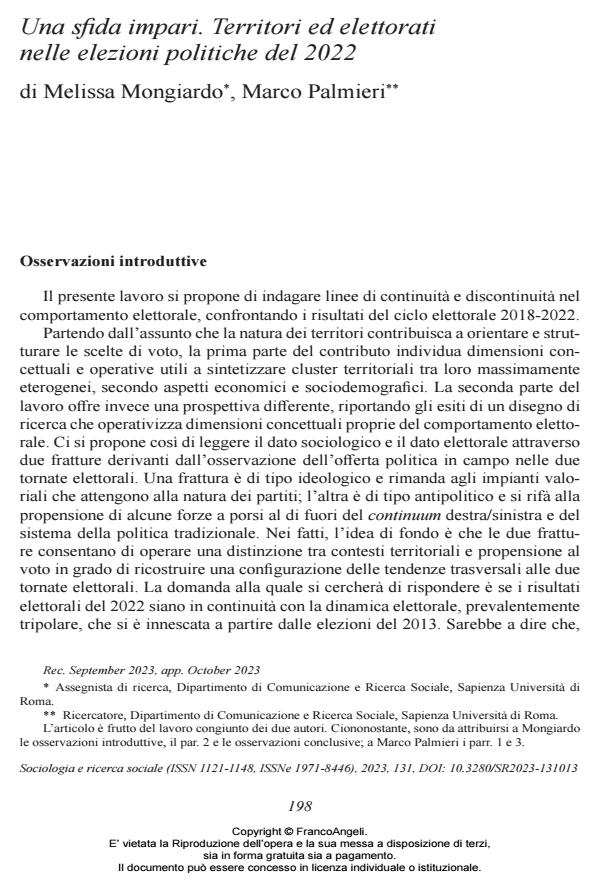An unequal challenge. Territories and voters in the 2022 general election
Journal title SOCIOLOGIA E RICERCA SOCIALE
Author/s Melissa Mongiardo, Marco Palmieri
Publishing Year 2023 Issue 2023/131 Language Italian
Pages 18 P. 198-215 File size 303 KB
DOI 10.3280/SR2023-131013
DOI is like a bar code for intellectual property: to have more infomation
click here
Below, you can see the article first page
If you want to buy this article in PDF format, you can do it, following the instructions to buy download credits

FrancoAngeli is member of Publishers International Linking Association, Inc (PILA), a not-for-profit association which run the CrossRef service enabling links to and from online scholarly content.
Starting from the assumption that the nature of the regional areas contributes to the orientation of voting choices, this study investigates the lines of continuity and discontinuity in the electoral behavior of Italians by comparing the 2018- 2022 election results. Taking into account the sociological dimension of the various regions of Ita- ly, regarding the economic and socio-demographic aspects of the constituencies, and the electoral dimension, regarding voting behavior and political supply, the question arises: «Did the 2022 general elections act in continuity with a tripolar dynamic that became rooted in 2013 or trigger a new electoral dynamic?».
- C. Biancalana, G. Legnante (a c. di) (2017), Partiti ed elettori in tempi di crisi. Le basi sociali di quattro partiti anti-establishment, Fondazione Giangiacomo Feltrinelli, Milano.
- R. Biorcio, P. Natale, P. (2018), Il Movimento 5 Stelle: dalla protesta al governo, Mimesis, Milano.
- M. Calise (2000), Il partito personale, Roma-Bari, Laterza.
- M. Calise (2016), La democrazia del leader, Roma-Bari, Laterza.
- I. Diamanti (2009), Mappe dell’Italia politica. Bianco, rosso, verde, azzurro e… tricolore, Bo- logna, il Mulino.
- I. Diamanti (2013), Un salto nel voto: ritratto politico dell’Italia di oggi, Roma-Bari, Laterza.
- S.R. Katz, P. Mair (1995), «Changing Models of Party Organization and Party Democracy: The Emergence of the Cartel Party», Party Politics, 1, pp. 5-28.
- P. Ignazi (2013), Forza senza legittimità: il vicolo cieco dei partiti, Roma-Bari, Laterza.
- P. Ignazi (2018), I partiti in Italia dal 1945 al 2018, Bologna, il Mulino.
- O. Kirchheimer (1966), The transformation of the Western European party systems, in J. LaPa- lombara, M. Weiner (1966), Political parties and political development, Princeton, Prince- ton University Press.
- S.M. Lipset, S. Rokkan (1967), Cleavages Structures, Party Systems and Voter Alignments: An Introduction, in S.M. Lipset, S. Rokkan (eds.), Party Systems and Voter Alignments: Cross National Perspectives, New York, Free Press.
- C. Lombardo, C. Coluccia (2018), Vecchie fratture, nuovi insediamenti, in C. Lombardo, E. No- velli, C. Ruggiero (a c. di), La società nelle urne. Strategie comunicative, attori e risultati delle elezioni politiche 2018, Milano, FrancoAngeli.
Melissa Mongiardo, Marco Palmieri, Una sfida impari. Territori ed elettorati nelle elezioni politiche del 2022 in "SOCIOLOGIA E RICERCA SOCIALE " 131/2023, pp 198-215, DOI: 10.3280/SR2023-131013